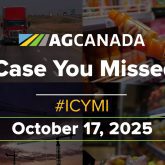An Alberta government researcher believes fertilizer prices could creep higher by next spring if commodity prices remain strong.
“If (fertilizer) prices are going to go up, they probably are going to be up there for a little while … as long as the market will bear it,” said Ross McKenzie, an agronomy research scientist with Alberta Agriculture.
“Most fertilizer prices now are similar to what they were this past spring, but price increases on a number of fertilizer products are expected either later this fall or by spring 2012.”
Read Also

Feds propose overhaul of chronic wasting disease control program
Chronic Wasting disease control program getting updated by Canadian Food Inspection Agency with feedback encouraged from producers.
In September, McKenzie called fertilizer dealers in Alberta and Agrium representatives to get a sense of prices for several fertilizer products. His informal survey estimated an average price of $600 per tonne for urea 46-0-0 and an average price of $775 per tonne for MAP phosphate 11-52-0, as of mid-September in Alberta.
Based on his conversations with dealers, McKenzie expects prices to rise throughout the fall.
Urea 46-0-0 would likely sell at $650 per tonne by November and MAP 11-52-0 would probably rise to $850 per tonne by November or December.
Alberta Agriculture and Wild Rose Agricultural Producers do a monthly input survey and as of Sept. 30 found urea 46-0-0 at $640.40 and MAP 11-52-0 at $$830.14
The U.S. Department of Agriculture provides a bi-weekly snapshot of the fertilizer market, based on prices in Illinois. The USDA Illinois Production Cost Report, which posts prices in short tons, for Oct. 27 indicated average prices of urea 46-0-0 at $625, anhydrous ammonia at $851 and MAP 11-52-0 at $731.
Prices in March were urea 46-0-0 at $508 per ton, anhydrous ammonia at $793 and MAP 11-52-0 at $712.
Prices in mid-October 2010 were urea 46-0-0 at $452 per ton, anhydrous ammonia at $678 and MAP 11-52-0 at $637.
David Asbridge, president and senior economist with NPK Fertilizer Advisory Service in St. Louis, Missouri, thinks the current price rally might not hold and prices could be lower in spring.
In an August interview, he agreed that nitrogen fertilizer prices were likely to rise this fall because corn acres in the U.S. are expected to increase in 2012. More corn acres increase the demand for nitrogen, which in turn puts upward pressure on prices.
However, Asbridge also said prices should drop by next spring because global supply is outstripping demand, which means fertilizer manufacturers may soon have excess inventory on hand.
For example, the Chinese government imposed a stiff export tariff on certain types of fertilizers a year ago to ensure domestic supply. Normally, such a decision would tighten global fertilizer supplies, but nothing has really changed, said George Silva, a fertility expert with Michigan State University, because Chinese companies continue to sell fertilizer into the global marketplace.
“If you go on the internet to find out where you can buy nitrogen, or phosphorus, a lot of Chinese companies come up,” Silva said.
“Even if the government wants to clamp down and not export fertilizer, I don’t think anything has taken hold yet.”
As well, there were fears earlier this year that the overthrow of the Egyptian government would disrupt urea supplies. However, Egypt continues to be one the world’s major suppliers of urea, Silva said.
Supply may exceed demand but a corresponding price drop in Western Canada may not occur because many farmers have produced above average crops this year and received good grain prices, McKenzie said.
“When farmers are making a bit more money, input suppliers also want to see their fair share of the profits,” McKenzie said in an article on the Alberta Agriculture website.















